Overview
In our lab we cool down atomic gases which are about a million times thinner than air to temperatures about a billionth of a degree above absolute zero. In these conditions quantum mechanical effects become essential: the atoms behave as matter waves which interfere, interact and can form very exotic states of matter such as superfluids, superconductors or quantum magnets. In some sense these phases are universal, as they appear in a broad range of other physical systems too, from liquid helium to complex solid-state materials, or even neutron stars.
Ultracold atomic gases provide an excellent platform to engineer the models underlying these phenomena, allowing us to study many-body quantum systems in a clean and very well controlled environment. On the one hand, they can be viewed as experimental quantum simulators for exploring challenging problems of condensed-matter physics such as neutron stars or high temperature superconductors. On the other hand, they also allow for the realization of completely novel systems of interesting properties, which do not exist in nature yet.
To learn more about our field of research you might want to read this Nature Physics review paper on quantum simulation in ultracold quantum gases.
We currently have two experiments in the group, the potassium and strontium labs. In Fall 2022, we will start a third (Rydberg) lab.
Potassium lab – Quantum gases with competing interactions
Engineering topological gauge theories in Raman-coupled Bose-Einstein condensates
Topological gauge theories describe the low-energy properties of certain strongly correlated quantum systems through effective weakly interacting models. A prime example is the Chern-Simons theory of fractional quantum Hall states, where anyonic excitations emerge from the coupling between weakly interacting matter particles and a density-dependent gauge field. While in traditional solid-state platforms such gauge theories are only convenient theoretical constructions, engineered quantum systems enable their direct implementation and provide a fertile playground to investigate their phenomenology without the need for strong interactions. In our experiment, we have very recently simulated a topological gauge theory by realising a one-dimensional reduction of the Chern-Simons theory (the chiral BF theory) in a potassium Bose-Einstein condensate. Using the local conservation laws of the theory we eliminate the gauge degrees of freedom in favour of chiral matter interactions, which we engineer by synthesising optically dressed atomic states with momentum-dependent scattering properties. This allows us to reveal the key properties of the chiral BF theory, predicted in the 90s but never observed so far: the formation of chiral solitons and the emergence of an electric field generated by the system itself. Our results expand the scope of quantum simulation to topological gauge theories and pave the way towards implementing analogous gauge theories in higher dimensions. For more information on our experiments, check our Nature paper. For a general audience introduction to our work, read the ICFO press release and the video we made on the story behind this project.
Quantum liquid droplets in a mixture of Bose-Einstein condensates
Liquids are fluids of fixed volume and very low compressibility, which remain self-bound in the absence of external confinement. Their stability normally stems from the balance of attractive and repulsive forces deriving from different parts of the inter-particle interaction potential. The typical inter-particle distance is therefore fixed by the potential range, and corresponds to a dense phase. All liquids were thought to share this feature, independently of their classical or quantum nature. Recent experiments demonstrated however that a very different type of quantum liquid, more than eight orders of magnitude more dilute, could be created with ultracold magnetic atoms. In our group we have experimentally observed for the first time such a liquid using instead a weakly interacting mixture of Bose-Einstein condensates.
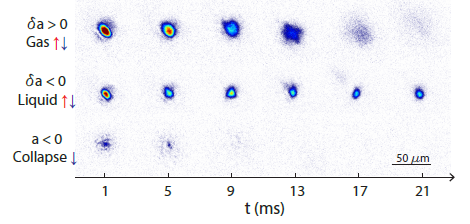 In our experiments, we use two condensates of potassium that interact only through standard isotropic contact forces. We observe that the atoms form liquid self-bound droplets and directly measure their size and ultra-low density using high-resolution imaging. Moreover, we verify experimentally that the droplets are stabilized by repulsive forces stemming from quantum fluctuations. Finally, for small atom numbers we observe how quantum pressure dissociates the droplets into an expanding gas, and map out the liquid-to-gas transition.
In our experiments, we use two condensates of potassium that interact only through standard isotropic contact forces. We observe that the atoms form liquid self-bound droplets and directly measure their size and ultra-low density using high-resolution imaging. Moreover, we verify experimentally that the droplets are stabilized by repulsive forces stemming from quantum fluctuations. Finally, for small atom numbers we observe how quantum pressure dissociates the droplets into an expanding gas, and map out the liquid-to-gas transition.
The existence of this novel type of ultradilute quantum liquid is a direct manifestation of quantum effects in a weakly interacting system, and its properties do not depend on the microscopic details of the interactions between the atoms. Therefore, our droplets constitute an ideal platform for benchmarking complex quantum many-body theories beyond the mean-field approximation. For more information on our experiments, check our Science paper, the accompanying Perspective and this News and Views article in Nature Physics. For a general audience introduction to our work, you might also find this Physics Today article and the ICFO press release useful.
Experimental apparatus
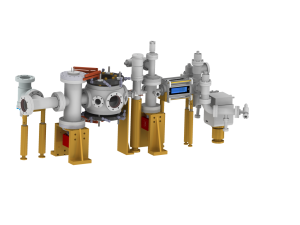
We started the construction of this experimental apparatus in the winter 2014. Although it routinely produces Bose-Einstein condensates since Spring 2015, it is under constant development like all our labs. As atomic species we use potassium, which has two bosonic isotopes and a fermionic one, allowing us to prepare degenerate quantum mixtures of bosonic or fermionic statistics. Furthermore, it offers an excellent control of the interatomic interactions thanks to favourable Feshbach resonances. Besides quantum liquid droplets and chiral superfluids, our setup should allow us to explore a broad range of physics problems, including supersolids, polaron physics, Hofstadter ladders, systems with p-wave interactions, and much more.
Don’t hesitate to contact us if you want to learn more about our current and future research plans!
Strontium lab – Cooperative effects in atom-photon scattering
In the strontium project, our objective is to harness the properties of two-electron atoms in optical lattices for quantum optics and quantum simulation experiments. We aim at engineering quantum many-body states combining photons and bosonic strontium atoms, in collaboration with the theory group of Darrick Chang at ICFO, and at exploiting the large nuclear spin of fermionic strontium atoms to investigate Hubbard models for spin larger than 1/2. To this end, we started in 2019 to develop a quantum gas microscope to image single strontium atoms in each lattice site and with full spin resolution.
Former research
Ultracold fermions in optical lattices (in Tilman Esslinger’s lattice lab at ETH Zurich)
In experiments performed at ETH Zurich we studied the properties of a degenerate Fermi gas of potassium atoms loaded into an artificial crystal of light. This system behaves very similarly to the gas of electrons in a solid, the electrons being replaced by fermionic atoms, and the ion crystalline structure by an optical lattice made of interfering laser beams. It is indeed described by one of the key hamiltonians of condensed matter physics, the Fermi-Hubbard model, which contains extremely rich phenomena: metallic and insulating phases, magnetic order, superconductivity… Our system allows us to study the fascinating physics of strongly correlated materials (such as for example high-temperature superconductors) in a clean and highly controlled environment, where all relevant parameters – hopping, interaction strength, lattice geometry, filling – can be precisely adjusted. You will find a good review on Fermi-Hubbard physics with ultracold fermions in optical lattices here.
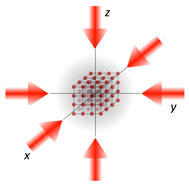
One intriguing example of strongly correlated state that we have experimentally studied is the Mott insulator, which occurs for a system with a half-filled band. There, a strong repulsive interaction between two spin states can lead to a localization of the atoms in the lattice sites and drive the transition from a metallic to an insulating state (in the publications page you will find several links to our work on the topic). At low temperatures one expects the spin degrees of freedom to order as well forming an antiferromagnetic, Néel-like state.
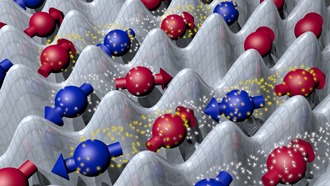 Recently we have been able to observe for the first time the appearance of short-range magnetic correlations in such a system, and studied how they are favored by certain lattice geometries. This is an important step for simulating the physics of quantum magnets using ultracold atoms, and on the long term trying to address open questions in quantum magnetism using this approach.
Recently we have been able to observe for the first time the appearance of short-range magnetic correlations in such a system, and studied how they are favored by certain lattice geometries. This is an important step for simulating the physics of quantum magnets using ultracold atoms, and on the long term trying to address open questions in quantum magnetism using this approach.
For more information, you could have a look at our Science paper and this Science perspective. For a more general introduction, you might also find these links to Physics World and ETH Life useful.
Creating artificial solids using ultracold atoms also allows us to engineer completely new materials which do not exist in the solid state world.
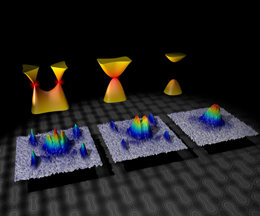
For example, by loading a non-interacting Fermi gas into a honeycomb structure, we realize artificial graphene and observe the presence of two Dirac points in the band structure. By tuning the geometry of the optical lattice we are able to adjust the properties of these Dirac points at will, moving them inside the Brillouin zone and changing the effective mass of the associated Dirac fermions. We can even observe how the two Dirac points annihilate each other when coming too close together, a situation which is presently out of reach in solid-state samples. By including interactions between the particles, these systems should also enable the study of “strongly correlated graphene” which otherwise does not exist in nature. For more information about these experiments you might want to read our Nature paper or this Nature News and Views. For general audience articles, check these Physics World and ETH Life links.
Superfluidity in ultracold Fermi gases (in Christophe Salomon’s lithium lab at ENS Paris)
In experiments performed at ENS Paris, we experimentally explored another classical problem of condensed matter physics: what is the fate of superconductivity in the presence of strong interactions between the particles?
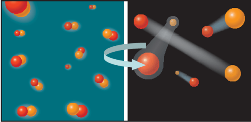 Superconductivity results from the superfluidity of the electron gas in a solid. Discovered in 1911 by Kammerlingh Onnes, it was only in 1957 that Bardeen, Cooper and Schrieffer managed to understand its microscopic origin. In a BCS superconductor, electrons form weakly bound pairs due to the effective attractive interactions mediated by their coupling to the lattice phonons. These Cooper pairs are stabilized by the presence of the Fermi sea and, as they are bosons, they can form a Bose-Einstein condensate which flows without resistance.
Superconductivity results from the superfluidity of the electron gas in a solid. Discovered in 1911 by Kammerlingh Onnes, it was only in 1957 that Bardeen, Cooper and Schrieffer managed to understand its microscopic origin. In a BCS superconductor, electrons form weakly bound pairs due to the effective attractive interactions mediated by their coupling to the lattice phonons. These Cooper pairs are stabilized by the presence of the Fermi sea and, as they are bosons, they can form a Bose-Einstein condensate which flows without resistance.
In the 80’s, Leggett, Nozières and Schmitt-Rink proposed a model unifying superfluidity in fermionic and bosonic systems. They showed that both phenomena could be understood as two limiting cases of the ground state of an attractive Fermi gas, the weakly interacting regime being associated to the BCS state and the strongly interacting limit corresponding to a Bose-Einstein condensate (BEC) of tightly bound dimers. In between, the BCS-BEC crossover is a regime of strong many-body quantum correlations that is extremely difficult to describe theoretically. Besides its fundamental interest, this regime is also believed to play a central role in some nuclear physics problems, describing for example the crust of neutron stars.
Ultracold Fermi gases have allowed for the realization of the BCS-BEC crossover, experimentally verifying the proposed scenario and making the quantitative study of this complex many-body problem possible. In the publications page you will find links to our early work on this topic. The experiments have nowadays reached such level of precision that they outperform classical computers and can be seen as true analog quantum computers (or quantum simulators) for this particular physics problem. You might want to have a look at the ENS Ultracold Fermi Gases Group to see the nice experiments they have recently done on the experimental setup that we built!
